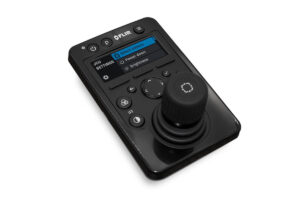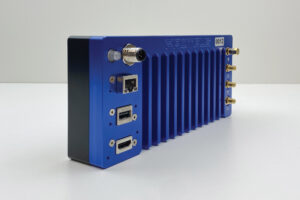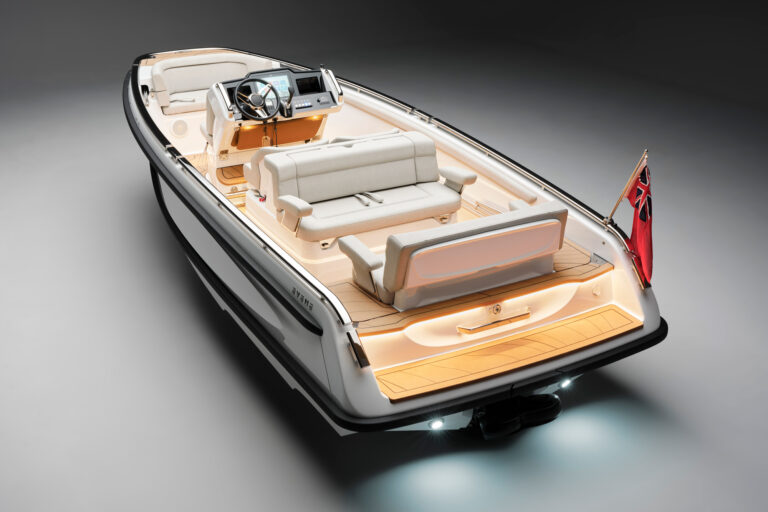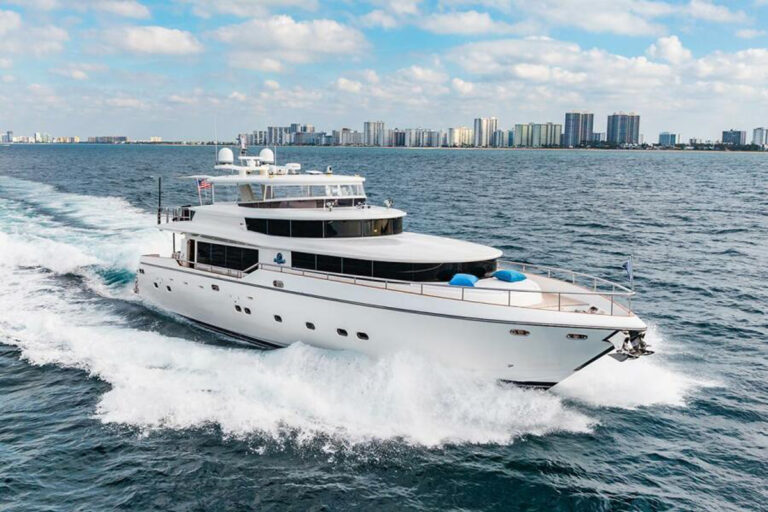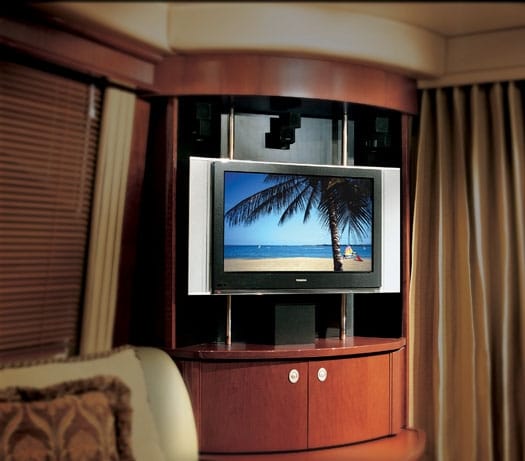
ychtelectjun1.jpg
Since daybreak, weve been on the water, cruising at moderate speed to our favorite anchorage. Were hot and a little salty, busting for a shower, a cold drink, a grilled steak, and a comfortable place to sit and eat and chat. And of course a satellite television, so we can watch the Red Sox tangle with the Yankees.
Since our ancestors walked upright and learned to use tools, we humans have longed to be warm and dry, well fed, and, no doubt, entertained. In todays world, entertainment is one way that we relieve our tension, and our hunger for it is the reason we see at least one TV on nearly every new boat over 40 feet. Were accustomed to getting our favorite weekly shows and sports specials offered by dockside cable hookups and satellite systems, but enjoying these diversions while we relax in the natural pleasures of remote locations, in our favorite spot on the boat is quite another. The answer to our entertainment needs has come in the form of small, lightweight, and relatively inexpensive satellite television receivers. We’re talking about stabilized tracking antennas, which react to motion so quickly and through such a large degree of tilt and swivel that we can watch TV while the boat is underway, at speed, in normal sea states.
Once upon a time, only cruise ships and superyachts had satellite TV that functioned at sea. Stabilized tracking antennas were large and heavy, in part because the gyro and drive mechanisms were large and heavy, as were the components that captured the signal and sent it to the receiver.
The cable that carried the TV signal from the antenna to the receiver limited the rotation (azimuth tracking) of the antenna to 720 degrees. After two full rotations of the antenna, the cable had reached its limit, causing the antenna to rotate 360 degrees in the opposite direction to reset the cable. This caused a brief interruption in the reception. A slip-ring rotary joint, instead of a cable, now provides the pathway for the signal, and it allows continuous, 360-degree tracking.
Nowadays, though, the smallest antennas perform as well as their larger siblings, so bigger isnt always better. Lets take a quick look at the numbers. A manufacturer may name its models by quoting the diameter of the dish. Sea Tel, for example, makes the Coastal 14, which has a 14-inch dish living within a 15.5-inch radome. The Sea-King 1500 has a 15-inch dish rotating within a 16-inch radome. Measurements also can deceive us. We may be tempted to regard an 18-inch model as being only 4 inches larger than a 14, but the actual difference in overall size isnt linear. An 18-inch antenna is 40 percent larger than its 14-inch sibling and weighs more than 50 percent more-30 pounds for the KVH 18-inch M5 instead of 19 pounds for the 14-inch M3DX.
If you add the weight and windage of a large TV antenna to that of the radar, GPS, VHF, and the boat’s superstructure, you have a significant amount of top hamper, or weight aloft. Traversing a stretch of water in a beam wind, even if the seas aren’t big, may heel the boat enough to require a few degrees on the leeward trim tab to balance her. This adds drag, which burns more fuel. Top hamper also adds to the difficulty of maneuvering in close quarters and a fresh breeze, because the wind blows the boat off course.
The downsizing of satellite TV antennas began before the turn of the 21st century, and since that time, the manufacturers have improved the performance from the top down. Domes these days are lightweight and rugged, yet allow the signal to pass through almost unimpeded. This extends the area of coverage and improves reception in bad weather, one of satellite TV’s unavoidable shortcomings. The drive motor that rotates and tilts the dish is so quiet that you’ll likely never hear one at work unless you’re standing next to the dome.
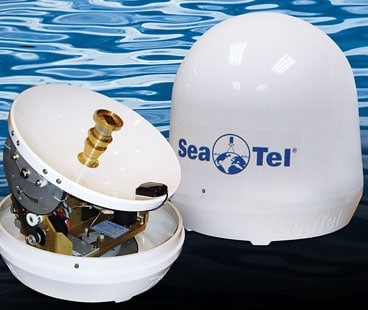
| | |
Most important to the remarkable performance of these satellite television antennas is the efficiency of the components that capture the signal and reflect it to the low-noise block (LNB), from which it enters the receiver to be transmitted to your television. Signals from the satellite strike the reflector dish, the concave component similar to those on rooftops all over the country. Unlike the dish of a household antenna, which is at least 18 inches in diameter and deeply concave, the dishes of modern marine antennas are smaller and flatter, which lets them function at a higher gain and efficiency. This style of dish uses a larger percentage of its surface to reflect the signal, further improving efficiency. It also lowers the center of weight in the antenna, which makes it more stable and able to respond quickly to the boat’s motion.
Like almost everything else in this world, the gyroscopic stabilizers used in these antennas aren’t a new idea, but their small size and light weight are. They react to a boat’s pitch and roll at 25 to 35 degrees per second and respond to changes in direction (the azimuth) at up to 90 degrees per second, keeping the antenna on the satellite’s beam and the picture on the TV intact. The range of azimuth is unlimited and the tracking continuous.
The signal bounces off the reflector, and the splash plate on the end of the feed tube captures it via the feed window. The feed window is made of a low-loss permeable material. Glass is used in the best, because it doesn’t have any particles of metal in it to degrade the signal. The signal then travels down the feed tube to the LNB.
According to satellite-system manufacturer KVH, the stacked LNB is the smallest (half the size of the standard LNB in an 18-inch antenna), lightest, and most efficient type. It reduces electronic noise and loss of signal strength. The stacked LNB allows more than one channel to travel over a single cable and lets you simultaneously watch a handful of channels if you have more than one receiver. The standard LNB requires a cable for each receiver.
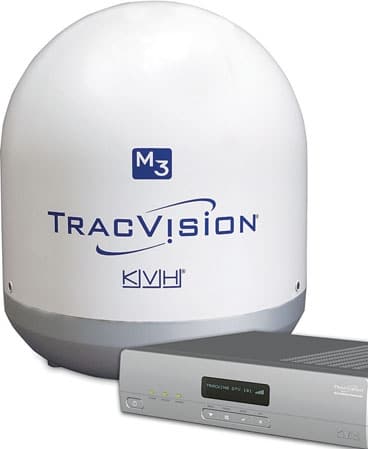
| | |
There are other things to consider when you shop for a satellite television system: Determine whether the system runs on AC or DC power. Make sure the available service providers, such as DirecTV or the Dish Network, carry the programs you want to watch. They have a wide-ranging selection, but there may be notable omissions, including local channels.
You can expect to pay about $2,500 to $5,000 for the hardware. Keep an eye on installation costs: If you’re handy this may be one to tackle yourself. The monthly subscription to the service will be an additional charge.
The game’s about to start, so you climb into the cozy berth and hope for a high-scoring contest. Meanwhile, your son and daughter are in the saloon watching “Pinks” on SpeedTV.
| TV CHANNELS KVH Industries, (401) 847-3327, www.kvh.com Raymarine, (800) 539-5539, www.raymarine.com Sea-King, (952) 922-6889, www.kingcontrols.com Sea Tel, (925) 798-7979, www.seatel.com |

